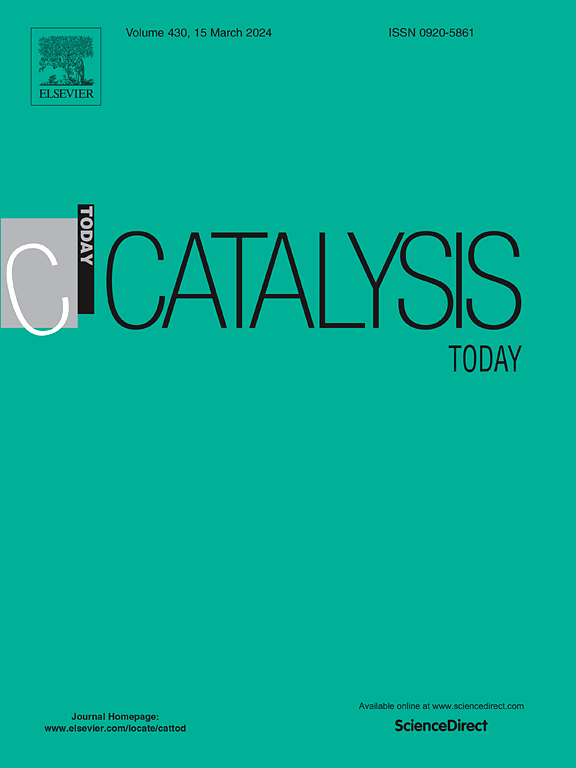调整负载钴费托催化剂的活性位点以提高硬蜡生产效率
IF 5.2
2区 化学
Q1 CHEMISTRY, APPLIED
引用次数: 0
摘要
Fischer-Tropsch (FT)工艺生产高质量的碳氢化合物产品,包括用于粘合剂、聚合物加工、化妆品和制药应用的硬蜡。Sasol使用沉淀的铁基催化剂商业化生产这些硬蜡,与钴基催化剂相比,这种催化剂具有成本效益。通过适当的化学促进,这些铁催化剂可以产生高α (C25-40 = 0.95)的产品板岩,适合生产硬蜡。然而,铁催化剂的特点是反应器寿命短,生产过程中产生废物,对高水分压敏感,二氧化碳产量高。这些问题可以通过使用钴浆催化剂来缓解。然而,钴对化学促进的有限反应构成了重大障碍,使得在相同条件下实现硬蜡选择性具有挑战性。本研究旨在通过调整负载钴催化剂的活性位点来提高硬蜡的选择性,使其在高每通转化率下稳定运行。在活化和FT合成过程中,纳米颗粒钴主要以六方密实(HCP)和面心立方(FCC)两种相存在。理论模拟表明,HCP相具有较好的活性,这是由于其位点排列的多样性较大。采用还原-碳化-还原(RCR)技术制备了富hcp钴催化剂。富hcp和FCC-HCP混合催化剂(后者由标准H2活化生产)的性能通过原位磁强计和实验室规模的FT测试进行了评估。催化剂制备和活化方法达到了中试水平,并在2英寸的泥浆泡柱中进行了测试,以评估催化剂的硬蜡收率,并生成用于应用测试的样品。本文章由计算机程序翻译,如有差异,请以英文原文为准。
Tuning the active sites of supported cobalt Fischer-Tropsch catalysts to enhance efficiency for hard wax production
The Fischer-Tropsch (FT) process yields high-quality hydrocarbon products, including hard waxes used in adhesives, polymer processing, cosmetics, and pharmaceutical applications. Sasol commercially produces these hard waxes using precipitated iron-based catalysts, which are cost-effective compared to cobalt catalysts. With proper chemical promotion, these iron catalysts can produce a high-alpha (C25–40 = 0.95) product slate, suitable for hard wax production. However, iron catalysts are characterised by short reactor lifetimes, waste generation during production, sensitivity to high water partial pressures, and high CO2 production. These issues can be mitigated by using cobalt slurry catalysts. However, cobalt’s limited responsiveness to chemical promotion poses a significant obstacle, making it challenging to achieve hard wax selectivity under the same conditions. This study aims to enhance hard wax selectivity by tuning the active sites of a supported cobalt catalyst for stable operation at high per pass conversion. During activation and FT synthesis, nanoparticulate cobalt mainly exists in two phases: hexagonal close-packed (HCP) and face-centred cubic (FCC). Theoretical simulations indicated that the HCP phase has superior activity due to a greater variety of site arrangements. A reduction-carbiding-reduction (RCR) technique was developed to prepare HCP-rich cobalt catalysts. The performance of HCP-rich and FCC-HCP mixed catalysts (the latter produced by standard H2 activation) were assessed via in-situ magnetometry and lab-scale FT testing. The catalyst preparation and activation methods were scaled up to a pilot level and tested in a 2-inch slurry bubble column to evaluate catalyst hard wax yield, and to generate samples for application testing.
求助全文
通过发布文献求助,成功后即可免费获取论文全文。
去求助
来源期刊

Catalysis Today
化学-工程:化工
CiteScore
11.50
自引率
3.80%
发文量
573
审稿时长
2.9 months
期刊介绍:
Catalysis Today focuses on the rapid publication of original invited papers devoted to currently important topics in catalysis and related subjects. The journal only publishes special issues (Proposing a Catalysis Today Special Issue), each of which is supervised by Guest Editors who recruit individual papers and oversee the peer review process. Catalysis Today offers researchers in the field of catalysis in-depth overviews of topical issues.
Both fundamental and applied aspects of catalysis are covered. Subjects such as catalysis of immobilized organometallic and biocatalytic systems are welcome. Subjects related to catalysis such as experimental techniques, adsorption, process technology, synthesis, in situ characterization, computational, theoretical modeling, imaging and others are included if there is a clear relationship to catalysis.
 求助内容:
求助内容: 应助结果提醒方式:
应助结果提醒方式:


